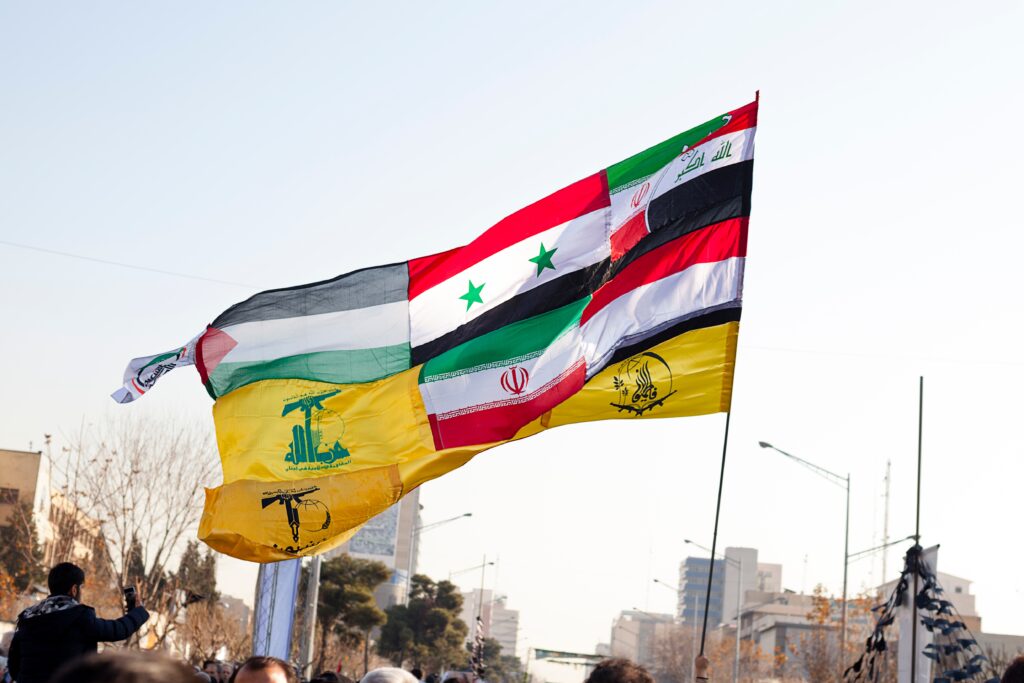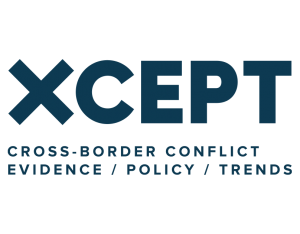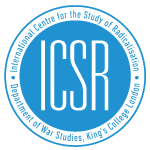In this interview, Clara May, Communications Manager for the Cross-Border Conflict Evidence, Policy and Trends (XCEPT) project at King’s College London, speaks to Dr Inna Rudolf about her research on the Islamic Resistance in Iraq (IRI) and the Popular Mobilisation Forces (PMF), and explores why we need to challenge the idea that Shi’a militants are simply Iranian proxies.

The flags of the allied resistance groups with Iran. Tehran, 2020. Credit: Shutterstock/saeediex
Clara May: You’ve recently published two papers for XCEPT on the resistance scene in Iraq. What do you argue?
Inna Rudolf: The goal of my articles was to shed light on the landscape of Islamic resistance factions in Iraq and to provide nuance regarding the differences between the Islamic Resistance in Iraq (IRI) and the Popular Mobilisation Forces (PMF), otherwise known as hashd. The IRI consists of different resistance factions that have, specifically since the events of 7 October 2023, been engaging in armed operations outside of the formal chain of command in Iraq, and the PMF is a state-recognised paramilitary umbrella group, which is recognised as part of the Iraqi armed forces. In most of the public discourse, however, the two umbrella organisations are often confused.
In my paper, All the Mahdi’s Men: Contextualising Nuances Within Iraq’s Islamic Resistance, I examine the ideological, historical, political, and pragmatic factors shaping the sometimes diverging resistance practices favoured by Asa’ib Ahl al-Haqq (AAH) and Kata’ib Hezbollah (KH), two prominent Iran-leaning PMF factions. In The war on Gaza and Iraq’s resistance state, I explore how the differing responses of Iraqi resistance factions to Israel’s war on Gaza reflect their efforts to balance domestic and transnational considerations.
Most analysis of the resistance factions in Iraq considers the groups through the lens of proxy warfare, neglecting their agency and organisational identity, and instead framing them as pawns in a geopolitical chess match. This simplified portrayal is not only incorrect, but it is also dangerous, as it can lead to misguided policy decisions. It is important to understand that these groups have autonomy and possess agency to make decisions based on their own identity, values, interests, and ambitions.
In both articles, I sought to offer a fresh analytical perspective, allowing us to move away from seeing the groups as simply remotely controlled proxy actors and instead to consider their ability to act independently, while pursuing their own domestic and transnational visions. If we can understand the motivations, identity, and agency at the group level, this will allow us to paint a more accurate picture of the dynamics of the Islamic resistance landscape and thereby to adequately inform policymaking.
CM: Why is the agency of these factions so often overlooked, and why is it important to highlight this?
IR: The IRI is an umbrella brand, and there is no accurate data available on its operational capacities or the numbers of its constitutive members. As a result, it’s very difficult to trace which factions were involved in particular attacks. It’s plausible that, in some instances, there has been a higher degree of co-ordination between different groups, and, in other instances, one faction may have chosen to take the lead, while the others have merely followed suit or claimed credits.
I argue there is a logic to maintaining this ambiguity. Particularly for Iran-affiliated groups in the IRI which also have a presence in the PMF, it’s important not to jeopardise their affiliation with the PMF and the integrity of the paramilitary structure as a whole. The PMF provides a source of legitimacy, legal cover, economic benefits, and access to power, and it also retains a sacred status, as its origin is grounded in the fatwa of Grand Ayatollah Ali al-Sistani. Attributing attacks to the IRI umbrella, therefore, rather than to specific PMF groups, provides those factions with presumedly double membership with a convenient smoke screen. This is something that has allowed many of the veteran Iraqi resistance actors to pursue their domestic agendas while, at the same time, still positioning themselves as defenders of a transnational resistance cause.
CM: If the militias all operate, to a degree, on their own terms, to what extent can we consider them as proxies of Iran?
IR: I always try to argue against this simplistic application of the label ‘proxy warrior’. Firstly, because there is no catch-all definition of what being a proxy entails, and secondly, because the term in itself is very static.
If a group engages in a military operation that involves actors from the so-called Axis of Resistance, or that aligns with Iran’s general interests, there is a tendency to believe that this group must be acting on the orders of Iran. Similarly, if a group chooses not to engage in such operations, then the assumption is that this conduct or hesitation signals a move away from Iran. While, in some cases, both of these presumptions may turn out to be true, neither of them necessarily reflects the real-time calculations of the actor involved. For instance, a group that is ideologically in sync with Iran’s vision for the region may also be focused on domestic matters and hence decide not to get engaged in armed resistance operations on Iraqi soil. Similarly, another faction may be opposed to some of Iran’s day to day policies regarding Iraq and its neighbours, but still decide to execute kinetic operations against Israel or US-led coalition forces, regardless of whether military escalation is in Iran’s imminent interest. As I argue in my papers, the way in which the Iraqi militants practice resistance is shaped by a complex interplay of motivations, ideological convictions, and interests, with each group possessing distinct and constantly evolving priorities, visions, and agendas.
We also need to consider the agility and learning curve of these veteran militant formations. A group may have acted as a conventional proxy agent under specific circumstances at a certain point in time, but its positioning vis-à-vis the Iran-led Axis of Resistance can evolve over the years. At a later point in time, the same group may have representatives in parliament, for example, and would re-evaluate the extent to which it wants to leverage its connections to Iran and other Axis actors. The relationship between Iran and the Iran-aligned militants is fluid and can’t be neatly summed up by the term ‘proxy warfare’.
One other key issue I want to highlight here is that sometimes we can be misled into thinking that Iran’s main interest in the PMF is in flexing the paramilitary’s muscle strength and exploiting its combat capabilities. Having pro-Iranian factions in the PMF means having allies embedded in a security agency which offers access to formal state legitimacy, financial resources, and domestic political leverage. This is far more beneficial to the Islamic Republic, especially at a time when Iran is politically and economically weakened and is likely to suffer further now that President Trump has restored his ‘maximum pressure’ campaign. Being able to rely on support from factions in the PMF also enables Iran to benefit from the smoke screen I mentioned earlier. The ambiguity means that Iran can play the PMF as a bargaining chip to sustain a threat perception, but it also offers Iran an opportunity to engage in plausible deniability where needed or whenever the factions’ affairs or readiness to escalate tend to spin out of control.
CM: Why is it important to understand the motivations of these groups?
IR: It’s important to know what drives the different factions in order to understand how best to evaluate their actions and engage them accordingly. If you believe a group is simply acting as an Iranian proxy, your approach may neglect the group’s embeddedness in domestic formal and informal networks and therefore disregard the implications of an ill-timed targeted assassination campaign. Furthermore, if a group is pursuing a national political agenda in Iraq, you might have more success in sabotaging its influence and legitimacy claims if you simply focus on mapping and publicly highlighting incidents where it has acted outside of the formal chain of command of the state, or where it has disregarded or acted against the interests of Iraqi constituencies. Shedding light on such contradictions and exposing malign behaviour can, in the long run, be far more damaging to the group’s political and economic prospects than poorly executed targeting of its leadership cadres, especially whenever there is a risk of high collateral damage.
Similarly, it’s important to identify and acknowledge the ideological and structural differences between these groups if you are considering engaging them kinetically. If a member of a PMF-registered formation – which is part of the Iraqi security forces – is eliminated – let us say in the midst of a residential neighbourhood in the capital, this could be framed as a violation of Iraqi sovereignty. Such an action would simply give more fuel to the resistance rhetoric of Iraqi militants who claim that their ‘right to resist’ is rooted in the continued controversial presence of US forces, which is regarded by many of these factions as a form of foreign-imposed military occupation and thereby as a violation of Iraqi national sovereignty.
CM: The geopolitical landscape has dramatically changed in the last five months. The Axis of Resistance has been significantly weakened. Israel has broken the ceasefire deal with Hamas. The Iraqi Prime Minister has called for stronger ties with the US. What does this mean for the Iraqi resistance?
IR: The situation is continually evolving, but there are three key points to highlight. The first is that, despite widespread speculation, there has been no interference from the PMF in Syria following the fall of the Assad regime. The Iraqi government has shown a strong focus on restoring a degree of what we in a Western context would refer to as a state monopoly on violence, but this shouldn’t be mistaken for a disarmament of the PMF or a top-down stripping of their power. In the Iraqi security and political landscape, it is not uncommon for political parties to entertain an affiliated armed wing. By law, the PMF is part of the Iraqi security forces and so having registered brigades under the PMF roof is not viewed as an anomaly or even a violation. The PMF will thus undoubtedly continue to play a crucial role in Iraq’s security sector, but it remains to be seen whether the current Prime Minister will succeed in restraining certain PMF affiliates that act outside of the formal chain of command.
The second point to consider is the volatile dynamics in the security relationship between the US and Iraq. The Iraqi Prime Minister has signalled that the focus would be on transforming the security assistance received from the US-led coalition forces into a bilateral security sector cooperation between the US and Iraq. Even pro-Iranian militants tend to appreciate the need to continue cooperating with the US in the security field, especially with concerns over the resurgence of ISIS and a possible spillover of violence from Syria. However, provided such a beneficial arrangement does materialise, it would be quite a stretch for them to use this form of cooperation as a justification for waging armed resistance.
Furthermore, the breaking of the ceasefire between Israel and Hamas is likely to shape the domestic approaches of the resistance-leaning factions. Pro-Iranian factions in Iraq had announced a suspension of attacks on Israel following the news of a ceasefire, but, on numerous occasions since, they have signalled their continued commitment to defending the Palestinian cause and the rights of the Palestinian people. If Israel continues to attack Gaza, or if all parties fail to reach an inclusive agreement on ending the conflict that secures the future of Palestine, we are likely to see stronger responses coming from within Iraq. The perceived ‘responsibility to resist injustice’ is still central justification for the actions undertaken by representatives of Iraq’s Islamic resistance, regardless of whether or not this aligns with Iran’s geopolitical priorities. Without an end to Israel’s occupation of Palestinian territories and its continued violations of the truce agreement in Lebanon, it’s difficult to envision a scenario in which Iraq’s resistance warriors would voluntarily and sustainably lay down their weapons.
Nonetheless, while the moral imperative to defend the Palestinian cause offers a perpetual excuse for resistance-leaning factions to operate outside of the state’s chain of command, seasoned politicians from the Iran-leaning current are urgently seeking to project a more or less convincing veneer of a state monopoly over the use of force. The success of this delicate balancing act largely hinges on effectively managing the ongoing Security Sector Reform (SSR) process. The proclaimed goal is to neutralise rogue resistance factions – and prevent them from provoking an untimely military escalation in Iraq – by integrating them into a restructured and disciplined PMF, thereby reducing its perception as a challenge to state sovereignty. This manoeuvre seeks to appease Iraq’s American counterparts in the Trump administration, while consolidating the PMF’s status in the state defence infrastructure as an existential guarantee for the existing elite power-sharing framework.

This publication was produced as part of the XCEPT programme, a programme funded by UK International Development from the UK government. The views expressed do not necessarily reflect the UK government’s official policies.

